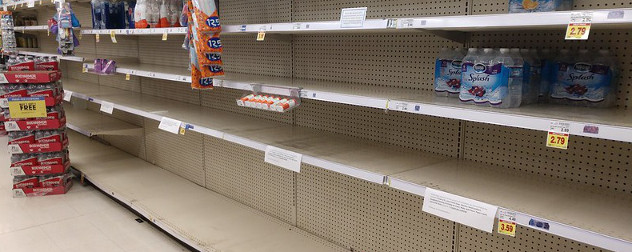On a trip to Vermont over Columbus Day weekend, I stopped at my favorite local diner for their signature Cajun Skillet breakfast of sausage, peppers, onions, Cajun spices, and home fries with two eggs on top and one Zantac (my special addition).
But they weren’t making the Cajun Skillet that afternoon; they had run out of spices. The homemade chicken soup was also finished, or “86ed” as they called it. They told me it was their busiest weekend ever.
Over the past year, people have built up cravings for a lot of things: appliances, cars, clothes, name-brand cereals and meals out. As consumers cut back, they held off on big purchases and spent less on daily necessities. In response, retailers chopped their inventories, hesitant to spend money on products that would go out of date or out of style. Factories, in turn, scaled back their production. Last December, U.S. factory inventories dropped by 1.9 percent, the largest monthly decline in 62 years of record-keeping, according to Bloomberg.
Now, as consumers straggle back to the malls to restock their empty pantries and closets, they are finding some stores are just as empty. Bill Emerson, a retail consultant and an expert in supply chain management, said “zombie stores,” with recession-adjusted inventories “look like they’re going out of business.” An August report from the National Retail Federation and IHS Global Insight revealed that the amount of cargo coming into the U.S., which is often used as a proxy for retail inventories, was at its lowest level in at least seven years.
Consumer confidence remains low. After an upswing in August, confidence fell in both September and October. However, there may be another factor that retailers have not accounted for, and that is pent-up demand. With even a modest return of confidence could come large increases in sales as customers make the purchases they deferred when the recession was at its worst. At the end of the 1980 recession, when economists predicted that sales figures would continue to be dismal in the third quarter, they instead bounced up 5.4 percent, buoyed by delayed spending.
While the rebound may not be as extreme this time, sales figures are already starting to pick up in some industries. Gartner, a research firm, estimated recently that spending on computer hardware, software and services will increase 3.3 percent in 2010. Before, it was predicting only a 2.3 percent increase. Intel had a strong third quarter. Chief Executive Paul Otellini attributed the company’s success to high demand for netbooks and laptops.
“Wallets are starting to free up,” Dirk Meyer, CEO of Advanced Micro Devices, Inc., said. He expects that sales of technology products to businesses, which all but stopped during the recession, will resume next year.
On the way down, companies struggled to cut inventories quickly enough to keep up with the rapid drop in demand. They are likely to lag on the way up as well. When retailers did their major buying for the holiday season in the early spring, most were unwilling to bet on a release of pent-up demand. While many held back some money to make last minute buys if the economy picked up, manufacturers are unlikely to be able to provide a rapid infusion of products, since they, too, scaled back their inventories during the recession.
Paula Rosenblum, a managing partner at the research and consulting firm Retail Systems Research LLC, said she is “really worried about the holiday season because we’ve got low inventories and expectations of promotions. Retailers are under-bought without question.”
Customers should be prepared for pockets of shortages and should brace themselves for the possibility that some of their cravings may remain unsatisfied, even if they are willing to spend. My wife recently was shopping for clothes for our daughter at Gap.com, but she was repeatedly frustrated by messages informing her that the item she had selected was only available in a limited number of sizes.
Eventually, retailers and manufacturers will respond to renewed demand. Lower unemployment rates will further boost consumer confidence, ensuring that there are consumers willing to peruse the restocked shelves. This economic recovery will strengthen.
In the meantime, there may not be enough Cajun spices or homemade chicken soup to go around.










November 19, 2009 - 3:18 pm
EDITOR’S NOTE: After this item was published, Paula Rosenblum of Retail Systems Research LLC wrote to inform us that her organization is a retail business technology research firm; they are not consultants.